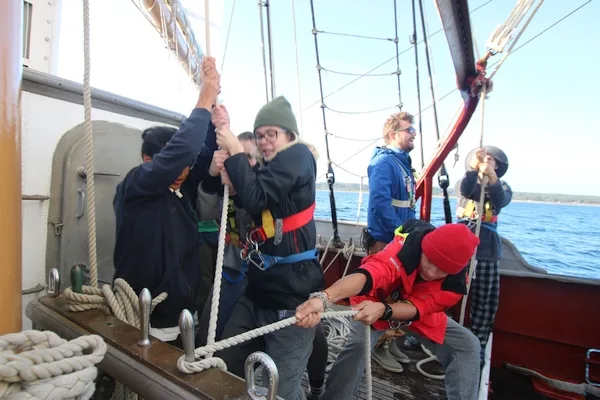News
Cramer Culture = Sailing and Science

Ship’s Log
Ship’s position
41° 21.8’ N x 070° 53.8’ W
Weather/Wind/Sail Plan
Sailing on a port tack under staysails and shallow reefed main sail. Winds east Beaufort Force 5, partly cloudy, high, wispy cirrus clouds.
Description of location
Sailing just south of Gay Head Lighthouse on Martha’s Vineyard.
It has been a busy couple of days and it can be a challenging transition: shore life to a life onboard a sailing scientific research ship at sea! There is a new language, new customs, a new culture with true responsibilityand a need to trust in your shipmates to do their jobs to keep everyone safe. I am happy to report that all are acclimating well to this new environment, soaking up all the information, rising to the challenges, and looking out for each other. A nice community of sailor-scientists is forming on the Corwith Cramer. And nearly all have their sea legs!
 Taylor, Anna, and Stephanie haul on the mainsail sheet during gybing practice
Taylor, Anna, and Stephanie haul on the mainsail sheet during gybing practice
Today was spent sailing and deploying all manner of oceanographic instruments in the water. And all the while, Gay Head lighthouse off in the distance. The standard Watch rotation has now begun with the students organized into A, B and C watches taking turns standing the following four Watch periods:
Dawn Watch: 0100 to 0700 AM
Morning Watch: 0700 to 1300 (1PM)
Afternoon Watch: 1300 to 1900 (7PM)
Evening Watch: 1900 to 0100 AM the next day.
 Cramer under sail near sunset.
Cramer under sail near sunset.
Given the number of Watches and Watch periods there ends up being an advancing rotation of when each Watch stands a certain Watch period. Morning Watch was full of science deployments, while Afternoon Watch was when we held our daily Ship’s Meeting when the entire Cramer crew gathers for learning new lessons and general announcements. Today we focused on learning how to gybe the Cramer, a sailing maneuver that allows us to ‘spin-around’ and put the wind on a different side of the ship, effectively changing the direction we are sailing. A rather necessary skill if we are to make our way from New England to the Caribbean!
Soon, once the students are settled into the ship routine you will be hearing directly from them.
Cheers,
Jeff Schell, Chief Scientist